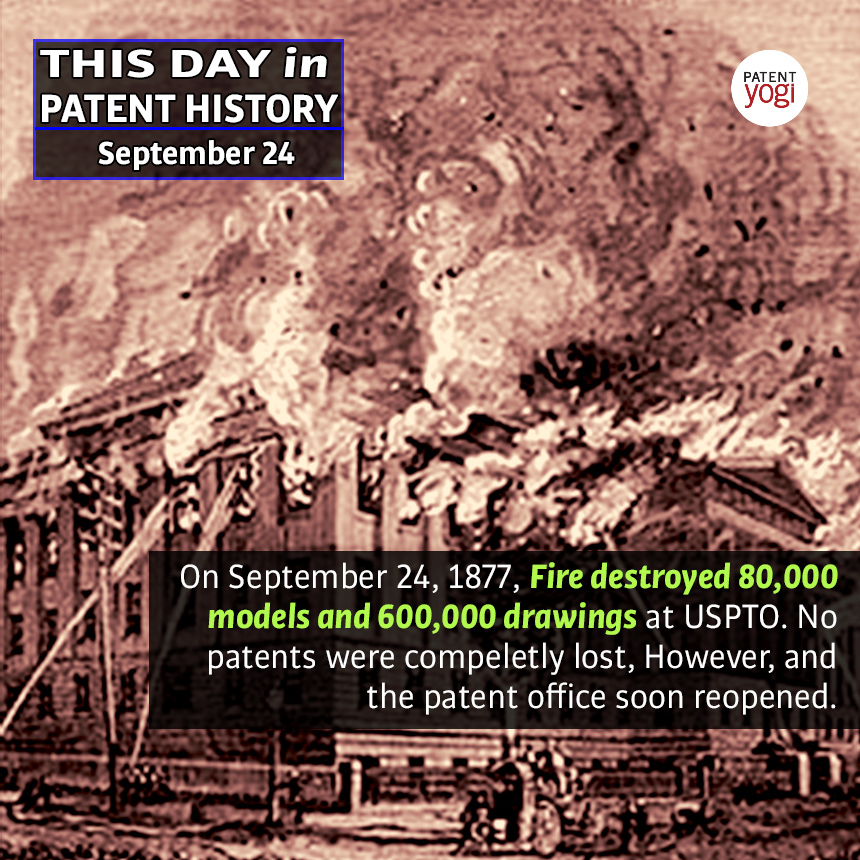
On September 24, 1877, Fire at USPTO destroyed 80,000 models and 600,000 drawings. No patents were completely lost, however, and the Patent Office soon reopened.
The Patent Office fire of 1877 was the second of several disastrous fires in the history of the U.S. Patent Office. It occurred in the Old Patent Office Building in Washington, D.C.
The Patent Office fire started at about 11 am on 24 September 1877. American author Bret Harte reports in The writings of Bret Harte that it was not known when or where the fire started. There have been guesses as to what started the fire, as the exact cause was never conclusively determined. One guess is that it was spontaneous combustion from chemical fumes in the upper part of one of the wings, as fumes collected there in condensed amounts, making it a potential fire hazard. There was a considerable amount of flammable material in that area and the roof was constructed of wood, which led to a rapid ignition and a fast-moving and disastrous building fire. The fire burned part of the upper portions of the north and west wings.[4] Another theory was that a lens might have caught the sun’s rays and focused them on a combustible object.
Others claim that it was an “unseasonably chilly” morning, and that a fire started by some copyists in their office grate emitted sparks that landed on the roof, igniting a wooden gutter screen. Before long, seemingly half the building was in flames. “The scene was one of awful grandeur,” reported the Evening Star. Despite architect Robert Mills’ best efforts, fire proofing was imperfect. “Ironically, although Mills’ successor as architect, Thomas U. Walter, had been one of the harshest critics, claiming that Mills’ vaulted ceilings would collapse in the event of fire, the conflagration actually consumed much of Walter’s shallower, iron-reinforced vaulting, and left the earlier ceilings intact.”
Although the building may have been considered fire-proof, “the contents were not.” An early part of the conflagration was a storage room used for rejected models, which may have totalled approximately 20,000 in number. While the patent office could loan those out to museums and other organizations, the increase in litigation made their preservation important and militated against such transfers. Contemporaneous reports state that in all between 65,000 and 80,000 models were damaged. These models included metal-working machines, wood-working machines, agricultural implements, carriages, wagons, railroading, mechanical, hydraulic and pneumatic engineering. A model of the original Eli Whitney cotton gin was among the models destroyed. In the south and west wings of the Patent Office there were some 100,000 models that were not damaged. Reports of the time show about two-fifths of all the models were damaged either by fire or water. An estimated 200,000 drawings were hastily carried out of the building before they were damaged.
In spite of these great monetary losses (many times those of the first Patent Office fire of 1836), there were no patents totally lost in the fire. There were duplicates of the drawings (a lesson learned from the first Patent Office fire in 1836) and it was just a matter of the expense of printing them again. Despite the loss of the upper floors and some accumulated “rubbish,” the Patent Office was soon reopened.
Reference: https://en.wikipedia.org/wiki/1877_U.S._Patent_Office_fire
